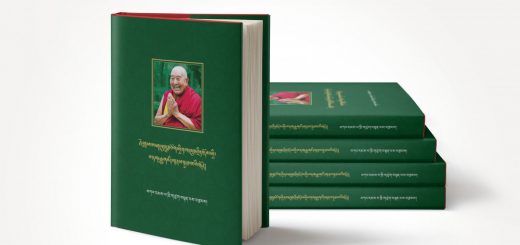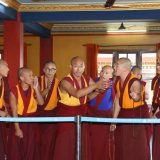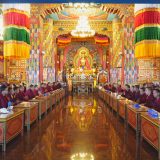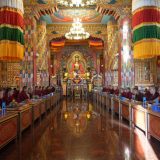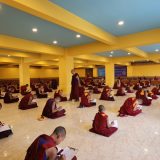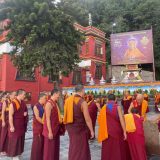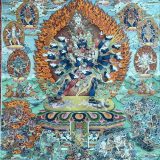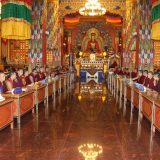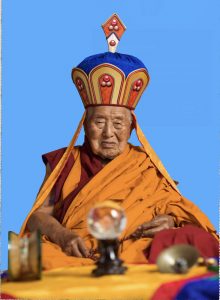Short biography of his Eminence Yongdzin Tenzin Namdak Rinpoche
- The lineage holder of three secret treasures, his Eminence the great
Yongdzin Tenzin Namdak Rinpoche, was born in the 15th Rabjung of
Tibetan calendar, in the fire-tiger of 1926 in the Khyungpo area of Khams. - From a young age, Rinpoche practiced the virtuous path of Bon, instructed
by many excellent Lamas, and showed great talent for drawing and painting. - From the age of 14, he worked as an artist at Rableg Yungdrung Ling
monastery. While creating murals in the monastery, he seized the
opportunity to learn from the monastery’s Khenpo, Ponlop, and Geshes.
From them he received the foundations of his education, as well as
empowerments, reading transmissions and instructions in Bon. - In 1942, Rinpoche went to the main monastery of Bon, Tashi Menri Ling, to
take the twenty-five vows of a (tsangma tsugphu) monk, and was ordained. - Then, after completing a pilgrimage through Nepal and upper Tibet,
visiting mount Tize (Kailash) and many other famous pilgrimage sites,
he returned to Yungdrung Ling monastery. - In 1944, Rinpoche met Yongdzin Tsultrim Gyamtso Rinpoche, known as
the Ponlop from Gongru, at his hermitage next to lake Gyer, and began
studying under him. - From 1948, he also studied with the renowned Yongdzin Sangye Tenzin
Rinpoche of Menri. From both masters, he received an education in the
ordinary liberal arts as well as in the subjects beyond the ordinary:
Sutra, Tantra, and Dzogchen. Each of these subjects he studied
exhaustively, in depth, learning the words with a profound understanding
of their meaning. - In the water-dragon year 1952 Rinpoche took the 250 vows of a
(drangsong) monk from the 31st Menri Trizin, Nyima Wangyal Rinpoche,
and was fully ordained. In the same year, Rinpoche graduated
from Shedra with the Geshe Rabjampa degree. - Later, Rinpoche himself became Menri Ponlop, and taught Sutra, Tantra,
Dzogchen and the liberal arts with great authority, liberating the
minds of thousands of students through knowledge. During his tenure
as Menri Ponlop, Rinpoche continued to receive inner, outer, and
secret empowerments, reading transmissions, and instructions of Bon
from Menri Khenchen Tenpa Lodroe, Khenchen Nyima Wangyal, the Shen
lineage-holder Tsamling Wangdue, and Yongdzin Sangye Tenzin, among
others. - In the wood-sheep year 1953, when [Rinpoche’s student] Sherab Lodroe
was enthroned as the 32nd Menri Trizin, and Tsultrim Wangden [also a
student of Rinpoche] became Menri Ponlop, Rinpoche went north to Dangra,
where he raised donations of food and livestock for the upkeep of Menri
monastery. - During the turmoil of 1959, Rinpoche was instrumental in hiding and
preserving the spiritual treasures of Menri monastery: reliquiary stupas,
scriptures, and statues. Having hidden the relics of Nyame Sherab Gyaltsen,
Rinpoche was grievously wounded, but managed to gather some of the most
important scriptures and to carry them safely with him to Nepal in 1960. - In 1961, Rinpoche went to London upon invitation of professor Snellgrove
and learned English. Together with prof. Snellgrove, Rinpoche selected and
translated excerpts of the Zigyi. The resulting book “the Nine Ways of
Bon” became widely known and served as a key to Bon for the whole world. - In 1964, upon his return to India, Rinpoche collected some of the most
important scriptures of Bon and had them reproduced and printed. - In 1965, when a group of Bonpo refugees arrived in India, Rinpoche
obtained residence permits for them in Himachal Pradesh in Northern
India, and, powerfully overcoming huge difficulties, established
a Bonpo settlement there, and a monastery, the new Menri. - In 1968, [after the death of the 32nd Menri Trizin] Rinpoche together
with a group of Lamas, Geshes, and students around Yungdrung Ling
Khenchen and Yongdzin Sangye Tenzin, in accordance with the traditional
selection process, found and enthroned the 33rd Menri Trizin. - The 33rd Menri Trizin Rinpoche and Yongdzin Rinpoche working together,
gradually re-established Pal Shenten Menri monastery with all its
inanimate and animate constituents, and its philosophy and meditation
schools, Shedra and Drubdra. In both of these Rinpoche taught the common
liberal arts as well as the great text cycles on the uncommon paths of
Sutra, Tantra, and Dzogchen, and gave empowerments, reading transmissions,
oral instructions and advice. - After Rinpoche had left snowy Tibet in 1960, he was able to visit it
again, the first time in 1986, and five times in all.
The connection between Tibet and ethnic Tibetan areas outside had been
forcibly cut; and now the cultural exchange that is like the flow
of life force was reconnected by Rinpoche’s visits.
The Bon tradition flourished through empowerments, reading transmissions,
oral instructions and advice. Rinpoche had new editions of Kanjur and
Tenjur printed. He encouraged the practice and teaching of Tibetan
medicine, of painting, and of other cultural techniques by continued
financial support. - In 1987, in Nepal’s capital Kathmandu, Rinpoche caused new Palden
Triten Norbutse monastery to be built from scratch on an empty lot.
Gradually, the inanimate and the animate, the buildings and their
inhabitants, developed together. When everything was perfected,
qualified students felt their minds uplifted, as if transported to
a pure land.
Moreover, in this monastery, Sutra, Tantra, and Dzogchen paths were and
are being taught and practiced without fail according to the texts and
tradition of Yungdrung Bon.
In the common liberal arts curriculum, Triten Norbutse is a place for
disquisitions and intent listening; and then there are Shedra
(philosophy school) and Gomdra (meditation school), a preparatory school,
and school of traditional Tibetan medicine.
Later, Shenten Dargye Ling in France and other Bon centers in the West
were established. The whole world over, Rinpoche taught, explained,
gave empowerments, reading transmissions, oral instructions and
advice.
Rinpoche’s disciples, in particular Khenchen Rinpoche and Ponlop
Rinpoche, followed where Rinpoche had led and are teaching and
instructing in the whole world.
With the income from his international teaching, Rinpoche supported
the monks and Geshes of Triten Norbutse and its Drubdra practitioners.
From Rinpoche’s teaching other activities for the benefit of all beings,
many hundreds of students benefited.
Then also, in the north-east of India, near Siliguri, Rinpoche
established a school, Snowy Tize general education school.
- Rinpoche taught Lamas, Trulkus and Geshes who, throughout the wide
world, spread the teachings of Yungdrung Bon among students who make
continuous progress by adhering to the path and practicing without
wavering.
Now and in the future the methods of practice continue to be taught.
Since his recent enthronement, his eminence the 34th Menri Trizin
also teaches all Bonpos the distinctions of what to adopt and what
to reject, and kindly gives advice and great blessings.
- In 1961, Rinpoche met his Eminence the Dalai Lama. He advised Rinpoche
and repeatedly encouraged him to teach Tibetans and Westerners, and, on
other occasions, highly praised Rinpoche’s teachings.
Moreover, a few years later, when Rinpoche was ill, his Eminence the
Dalai Lama exhorted everybody to recite long life rituals and prayers
for Rinpoche. Rinpoche was touched by these kind wishes. - Also, upon Rinpoche’s request, the Dalai Lama’s office recognized
the 33rd Menri Trizin, admitted a representative of Bon to the
Tibetan administration in Dharamsala, and authorized the establishment
of a Bon school of higher studies in Varanasi. All three of these
acts were in the best interest of Bon. - Also in the West, Bon centers were established. Rinpoche liberated
many thousands of students’ minds through his teachings. Rinpoche
collaborated with with eminent scholars of Bon on research about
Kanjur and Tenjur, Tibetan medicine, and other topics, and on
and new editions and translations into English of important texts.
This research resulted in dozens of scholarly works that were translated
into many languages. - Rinpoche’s own collected works, consisting of teachings and
commentaries on Bon Sutra, Tantra and Dzogchen, liberal arts and
sciences, and rituals amount to 22 volumes. - Every day without fail, Rinpoche read his daily recitation texts.
In his spare time, he was always seen to study a petcha. Rinpoche
observed the four daily practice sessions of a Dzogchenpa, never
neglecting even one. Without judgment, Rinpoche respected other
traditions, like a jewel scattering light in all directions. - In short, his Eminence Menri Yongdzin Lopon Tenzin Namdak Rinpoche
was the representative in his time of the Buddhas of the three times.
He had the fortune to live a full century spanning the eras of five
Menri Trizins.
In our difficult times, he was the central pillar of support.
In him, the teachings of the whole white hat Yungdrung Bon tradition
where concentrated into a single sphere. - In the end, when the great benefactor of all beings had exhausted
his time, in the 17th Rabjung of Tibetan calendar, in the wood-serpent
year 2025, at 7:45 in the morning of June 12, his consciousness, in
an unwavering state of meditation, entered the dimension of Bon.

